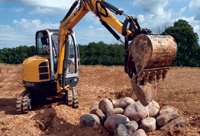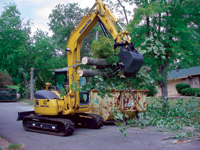The Perfect Pair

From peanut butter and jelly to the Fourth of July and fireworks, our image of one isn’t whole without the other. When it comes to inseparable duos in the small machine market — specifically the compact excavator industry — the durable bucket and thumb attachments fuse to create a tough and tumble work pair. When functioning alone, a bucket can excavate earth efficiently, but when combined with a thumb, the two become one powerful digging, loading and moving force (a giant metal hand to add to your work crew).
Before an operator can take advantage of this dynamic pair, they must first understand the ins and outs of bucket and thumb attachments. By learning how to size and use the equipment properly, an operator can benefit from their abilities to dig, move and place materials around a bustling jobsite.
The Bucket List
On a compact excavator, buckets are the most popular attachment, primarily used for digging and trenching, as well as loading and removing dirt. The widths of buckets range from 8 to 60 in. However, when outfitting a compact excavator with the attachment, the size of the machine should always be taken into consideration. The lifting and tipping capacity of a compact excavator must always be considered when installing attachments, explains Randy Bauserman, product manager for Komatsu Utility Division. The bucket capacity and payload should also be figured into the decision.
The scale of the project the machine is expected to perform is also a deciding factor in sizing a bucket purchase. Bucket widths should be chosen in accordance with jobsite demands. This will allow an operator to have the proper size attachment for his or her project, resulting in quicker cycle times.
“If the job is to dig a 12-in. wide trench, a 12-in. bucket is the tool of choice,” says Ron Grimstad, product manager for CEAttachments. “Using a bucket wider than 12 in. will result in slower cycle times and added labor when it’s time to backfill the trench. Using a bucket narrower than 12 in. will require more machine cycles to complete the job.”
The manufacturer of the compact excavator may also be a valuable resource in the search for the right bucket attachment. Since they are knowledgeable about the machine and its capabilities, the manufacturer can help pick out the best bucket for the excavator model.
Buckets can be attached to compact excavators in two different ways. The most common attachment is through a direct pin-on system, in which the bucket attaches directly to the compact excavator’s pins. A quick-coupler option is also available, providing a faster change between buckets and other attachments. The quick-coupler attachment is permanently pinned to the compact excavator attachment mounting points, allowing for less time in between attachment change-outs.
There are also mechanical and hydraulic quick-couplers for compact excavators. The mechanical couplers often use an over-center lever mechanism to latch the attachments, explains Bauserman. With hydraulic quick-couplers, the hydraulic controls located in the operator’s station are used to fasten and unlock the coupler to the attachments. Grimstad explains that the majority of quick- couplers work by hooking one of the bucket pins, then capturing the other pin with an over-center latching mechanism. A locking pin is provided and is required to be installed to prevent accidental bucket release.
“OSHA has issued a SHIB [Safety and Health Information Bulletin] relating to this issue, urging employers using quick-couplers to take the appropriate measures to prevent unintended bucket releases,” says Grimstad.
Kick the Buckets
When it comes to bucket attachments, there’s a buffet of features and styles to choose from. While the typical bucket attachment will fit the bill for a variety of digging projects, specialized buckets come equipped with unique features ready to tackle specific tasks. Alterations to the standard bucket body pave the way for the creation of a bucket designed to fulfill the operator’s needs and unique jobsite requirements. Bauserman notes that specialized buckets provide faster work ability in particular work applications.
Aside from traditional trenching and digging buckets, there are a variety of bucket attachments, including heavy-duty, ditch cleaning, coral rock, cemetery and slab removal buckets, to name a few, for an operator to consider for his or her excavator and specific projects.
The standard trenching bucket is typically one of the least expensive bucket designs and offers assistance in basic trenching applications. Its light-weight design is best suited for trenching in loose dirt. Heavy-duty trenching buckets are a popular choice among contractors. Thanks to a robust design of strong steel and durable teeth, these buckets are able to work in numerous jobsites with different soil types such as rocky or hard soil. Ditch cleaning buckets are used to clean canals, ditches or for slope work, explains Gary Wilt, president of TAG Mfg. These buckets have a smooth lip without teeth and are typically wider, around 36 to 60 in. Ditch cleaning buckets are also shallower and have less capacity than a standard trenching bucket. Coral rock buckets are designed to peel away at coral rock during digging applications. Utilizing a strong shell design and heavy-duty teeth, this bucket is a necessity for work areas in coastal locales like Florida and Hawaii.
Cemetery buckets, or bell-hole buckets, are also available and are designed to produce nearly straight-sided and flat-bottomed holes. Bauserman notes: “The buckets received their name from their popular use for grave digging and for producing smaller, precision-size holes used by utility companies.”
Grimstad adds that these buckets are made for extra bucket rotation, allowing the operator to dig the straight vertical walls and flat bottoms required for digging graves.
Slab removal buckets are used for hooking and loading cut slabs of pavement. The open sides allow the operator to slide the front of the bucket under a slab of pavement, pry the slab free and lift and load it, explains Grimstad. Typically, slab removal buckets are only available for the larger classes of compact excavators.
The price of a bucket attachment can range from $300 to $4,000, depending on manufacturer, size and options. For example, a coral rock bucket can cost anywhere from $400 to $2,000, while a slab removal bucket will run between $1,000 to $2,000.
All Thumbs
When it’s time for a bucket to take a break from excavating, a thumb attachment is brought on board to be a faithful sidekick in moving duties. Thumbs are used to compliment a bucket, turning it from a dig-only attachment to a piece of equipment capable of lifting and shifting materials around the work area. Similar to the thumb on a human’s hand, the attachment is able to snatch items up and hold them firmly in the bucket — enabling an operator to reposition the bucket’s contents throughout the busy jobsite, explains Wilt.
Operators can use thumb and bucket combos to handle a variety of applications, including landscaping tasks such as lifting and placing timbers, rocks or other landscaping materials, notes Bauserman. In addition, a thumb aids in tree, shrub and brush removal. By adding a thumb to a bucket, the combination can act as a grapple attachment, performing similar tasks without removing and attaching other equipment — saving time and hassle on the jobsite.
“Thumbs have an advantage over grapples due to the fact that when retracted, they lay against the bottom of the stick until needed, out of the way for normal digging operations of the excavator bucket,” says Grimstad.
There are two main types of thumb attachments for mini excavators — rigid and hydraulic. Rigid thumbs pivot and are put into position and locked manually. The operator must exit the machine to place the thumb in the desired work position. A mechanical link arm locks the thumb into place, allowing the thumb to work at a fixed angle to the bucket or to be stored against the excavator stick for regular digging work, says Bauserman. The bucket then moves to position and secures the work item between the attachments.

“Rigid thumbs make sense in applications where the thumb will be in use for extended periods of time in repetitive operations, such as moving or loading material like rocks, timbers and brush or demolition debris,” says Grimstad.
When the project requires lifting and moving items of various sizes, hydraulic thumbs provide the most relief. Since the hydraulic thumb is put in place hydraulically and doesn’t require the operator to get out of the machine, it is suited for jobs that require intermittent use between digging jobs and material moving, says Bauserman.
Prices for rigid thumbs range from $1,600 to around $2,800. Hydraulic thumbs cost around $2,000 on smaller excavators and $3,500 for a larger machine.
There are some guidelines when pairing a thumb and bucket attachment. Grimstad notes that thumbs are designed so that the end of the thumb mates with the tip or cutting edge of the bucket. Based on this design, the thumb should match the tip radius of the bucket.
Pam Stask is assistant editor of Compact Equipment.
Thumbs Up on Maintenance
General Upkeep Allows the Bucket and Thumb to Keep on Working
To be sure the trusty bucket and thumb duo works its hardest, proper
maintenance should be completed on the attachments. A bucket’s
maintenance regimen involves checking the wear on the teeth, which are
replaceable and should be changed when wearing becomes present. Special
concern and action should be taken when the bucket’s teeth have fallen
off.
“Never dig when teeth are missing,” explains Gary Wilt, president of
TAG Mfg. “By doing so, an operator can cause wear on the shank and
damage the retaining system, so it won’t hold the teeth into place.”
Ron Grimstad, product manager for CEAttachments, also suggests removing
any dirt that is caked on or in the bucket to minimize corrosion and
wear on the attachment.
Other bucket maintenance includes greasing the pins that hold the
attachment to the machine, as well as performing the daily and monthly
checks as indicated in the manufacturer’s manual. Periodic inspections
are recommended in hopes of finding minor maintenance issues, before
they become a major repair.
Regular daily inspections should be made on thumb attachments to check
for proper lubrication of pivot points and signs of structural failure,
notes Grimstad.
With hydraulic thumbs, maintenance checks should involve taking a look
at the cylinder and hose. Wilt also says to make sure the hydraulic
pressure is always set properly and to grease the thumb according to
manufacturer’s specifications.

Comments are closed here.